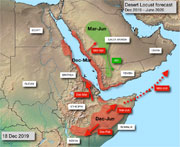A dangerous Desert Locust situation is developing in the Horn of Africa 
Current forecast (click for larger view) Desert Locust breeding continues in eastern Ethiopia and adjacent areas of Somalia. Although ground and aerial control operations are in progress in the Somali region of eastern Ethiopia, new immature swarms are expected to start forming in the Ogaden by the end of this month that could threaten crops. Some of these swarms are likely to move south towards northeast Kenya and adjacent areas of southern Somalia, However, as good rains fell over a large portion of the Ogaden and Somalia from Cyclone Pawan, many swarms are expected to remain in place, mature and lay eggs from late January onwards for another generation of breeding that would cause a substantial and dramatic increase in locusts.
A few more swarms are likely to form in previously infested areas in Afar of northeast Ethiopia, along the railway area between Dire Dawa and Djibouti, and on the coastal plains of northwest Somalia. Some of these swarms can move north to Eritrea while others will move to the Ogaden.
All efforts are required by national authorities to undertake regular surveys, timely reporting and efficient control, and to upscale these activities in the coming weeks and months.
Breeding is in progress along both sides of the Red Sea where several more swarms have formed on the northern coast of Yemen as well as a new generation of hatching. Some of the swarms moved north to adjacent coastal areas in southwest Saudi Arabia. Hatching and band formation are expected to start by the end of this month on the Red Sea coast of Saudi Arabia between Jeddah and the Yemen border where ground and aerial control operations treated more than 15 000 ha during the first week of December. In Sudan, ground and aerial control operations treated more than 12 000 ha of adult groups during the first half of this month in the summer breeding areas of the interior in order to reduce migration towards the winter breeding areas on the Red Sea coast. Limited control was carried out on the Red Sea coast in southeast Egypt. Hatching is expected to occur in the coming weeks along the western side of the Red Sea from Eritrea to southeast Egypt.
In South-West Asia, locust infestations are declining along both sides of the Indo-Pakistan border due to control operations, drying conditions and swarm migration towards the west. So far this month, India has treated nearly 1 800 ha and Pakistan more than 20 000 ha. Adult groups and swarms are expected to arrive in southwest Pakistan and southeast Iran during the next few weeks. Some swarms may continue moving west along the southern coast of Iran to areas of recent good rains. If temperatures remain warm, egg-laying could occur now, giving rise to hopper groups and bands in January; otherwise, breeding will commence in about February or March. Both countries are advised to be extremely vigilant in all areas and undertake regular surveys, supplemented by control operations whenever necessary.
Elsewhere, the Desert Locust situation remains calm. |